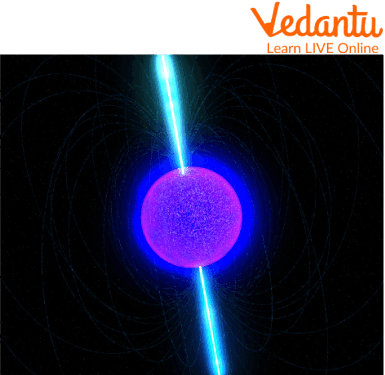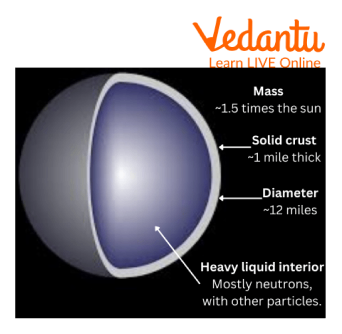




Why Study Neutron Stars? Key Applications & Competitive Exam Insights
Neutron stars are the densest stars in existence. They are so dense that one teaspoon of material from its centre would have the same mass as our entire Earth! They are formed when giant stars go supernova, which is when they collapse, and their centre can no longer support the weight of all the material it's composed of. This article explores how neutron stars form, their makeup, and a few key things you should know about them.
What is Neutron Star?
Any member of a class of highly dense, compact stars assumed to be predominantly made of neutrons is a neutron star. The average diameter of a neutron star is 20 km (12 miles). Their masses range from 1.18 to 1.97 times those of the Sun, with the majority being 1.35 times the Sun. They have exceptionally high mean densities, almost 1014 x that of water.
This is similar to the density of an atomic nucleus, and one may think of a neutron star as a massive nucleus. Where pressure is greatest, at the core of the star, it is not known for sure what is there. Most of the particles in the different layers are neutrons, likely in a "superfluid" condition.

Neutron Star
Properties of Neutron Stars
It has a small diameter, high density, powerful gravity, and a powerful magnetic field are the four main characteristics of neutron stars. Neutron stars are typically no larger than a city, with diameters of about a few kilometres. However, they are, at the minimum, 40% bigger than our Sun! Neutron stars have a density of around 1014 (100 trillion) fold greater than that of water. Neutron star material can carefully weigh up to one billion tonnes in a teaspoonful.
A neutron star's gravitational pull is inversely proportional to its squared radius and inversely proportional to its mass. Neutron stars, therefore, have extremely powerful gravitational fields. The surface of a neutron star is extremely smooth and spherical because all of the atoms are compressed as tightly as they can be. You would immediately disintegrate into elementary particles if you attempted to travel to a neutron star.

The Properties of a Neutron Star
Neutron Star Weight
Only big stars, defined as those weighing between 4 and 8 solar masses, can give rise to neutron stars. During a supernova, the core of these huge stars is frequently just as large as the Sun, if not bigger. The core alone needs to be between 1.3 and 2 percent of the weight of the Sun in order to fall down far enough to create a neutron star.
Neutron Star Collision
The collision of two neutron stars causes a kilonova. A kilonova is produced when two highly dense cores of a dead star collide. This is the collision's dazzling afterglow, composed of heavy elements in the decay process.
For a very long time, astronomers believed that heavy elements and precious metals were ejected by supernovae. However, in recent years, scientists have researched supernovae and discovered that there isn't enough density to support the number of these elements that are present in the world. This has disproved the idea. Scientists then came up with another hypothesis: Kilonovae is, in fact, in charge of dispersing these heavier materials throughout the cosmos.
Summary
A neutron star is a tiny, compact star almost entirely composed of neutrons. They are tiny stars with a radius of approximately 11–11.5 kilometres. They are roughly twice as massive as the Sun. They are the tiniest and densest stars that the universe is known to contain. They are all left of a massive star that had a supernova explosion. The star's density is comparable to that of an atom's nucleus. It was once believed that neutron stars were too faint to be seen. We are wrapping up this article with this information about neutron stars.
FAQs on Neutron Stars: Definition, Properties & Significance
1. What exactly is a neutron star?
A neutron star is the incredibly dense, collapsed core of a massive star that has exploded as a supernova. It is composed almost entirely of neutrons, which are packed tightly together by immense gravity. Despite having a small size, comparable to that of a city, a neutron star can have more mass than our Sun.
2. What are the main properties of a neutron star?
The most important properties that define a neutron star are:
- Extreme Density: A single teaspoon of neutron star material would weigh billions of tons. They are one of the densest types of objects known to exist in the universe.
- Small Size: A typical neutron star has a diameter of only about 20 kilometres.
- Intense Gravity: The gravitational field on the surface of a neutron star is about 200 billion times stronger than on Earth.
- Rapid Rotation: They spin incredibly fast, often hundreds of times per second, a result of conserving the angular momentum of the original, much larger star.
- Powerful Magnetic Fields: Their magnetic fields can be trillions of times stronger than Earth's.
3. How are neutron stars formed?
Neutron stars are formed from the supernova explosion of a massive star, typically one that is 8 to 20 times the mass of our Sun. When such a star runs out of nuclear fuel, its core collapses under its own immense gravity. The collapsing pressure is so great that it forces protons and electrons to combine into neutrons, creating a super-dense neutron core. The star's outer layers are violently ejected into space in the supernova, leaving only the compact neutron star behind.
4. What prevents a neutron star from collapsing into a black hole?
A neutron star is saved from collapsing into a black hole by a powerful quantum mechanical force called neutron degeneracy pressure. This pressure arises because neutrons are fermions and cannot occupy the same quantum state in the same space. It creates an outward push that counteracts the inward pull of gravity, establishing a stable, albeit extremely dense, state. If the star's core were more massive, gravity would overcome this pressure, leading to the formation of a black hole.
5. How is a neutron star different from a black hole?
The main difference between a neutron star and a black hole lies in the outcome of their parent star's core collapse. A neutron star is a physical object where the collapse was halted by neutron degeneracy pressure; it has a surface and is made of matter. In contrast, a black hole forms when the core is too massive for even this pressure to stop the collapse. Gravity wins completely, crushing the core into a singularity—a point of infinite density from which nothing, not even light, can escape.
6. Is a neutron star hotter than the Sun?
Yes, a young neutron star is significantly hotter than the Sun. While the Sun’s surface temperature is around 5,500 degrees Celsius, a newly formed neutron star can have a surface temperature of about 1 million degrees Celsius. They gradually cool over millions of years but remain incredibly hot for a very long time.
7. What would happen if a teaspoon of neutron star material was brought to Earth?
If a teaspoon of neutron star material were brought to Earth, it would not remain stable. The immense gravitational pressure that keeps it so dense only exists within the star itself. Without that pressure, the material would instantly and explosively expand. The neutrons would decay back into protons and electrons, releasing an enormous amount of energy, likely equivalent to the detonation of hundreds of powerful bombs.
8. How do astronomers detect neutron stars if they are so small and faint?
Astronomers detect neutron stars primarily through the radiation they emit. Many are observed as pulsars. As the neutron star rotates, its powerful magnetic field creates beams of radiation that sweep through space. If a beam points towards Earth, we detect a regular pulse, much like a cosmic lighthouse. We also detect neutron stars from the X-rays and gamma rays they emit due to their extreme temperatures or from matter falling onto them from a companion star.





















